Radar sounding of Ganymede: Attenuation and volume scattering losses estimation
- Roma Tre University, Italy (dipaolo@fis.uniroma3.it)
Radar for Icy Moons Exploration (RIME) is expected to sound the crust of the Jovian moon Ganymede down to a depth of 9 km. The presence of dust in the ice and a fragmented crust could give rise to both attenuation and volume scattering, potentially affecting radar propagation. We have performed simulations in three dielectric scenarios for dusty inclusions to estimate the two-way attenuation. The contribution of volume scattering has been evaluated in terms of two-way losses as a function of scatterer radius and porosity. Results show that both phenomena will not affect significantly the performance of RIME in the radar sounding of Ganymede.
Introduction
Thanks to the low attenuation of radio waves in the ice, the next ESA JUpiter ICy moons Explorer (JUICE) mission will host onboard the 9 MHz Radar for Icy Moons Exploration (RIME) (Bruzzone et al., 2013), and its main focus will be an extensive exploration of Ganymede. Radar performances on Ganymede have been recently evaluated considering the effect of surface clutter (Berquin et al., 2013; Ilyushin, 2014) or subsurface medium attenuation and volume scattering (Di Paolo et al., 2014; Heggy et al., 2017; Di Paolo et al., 2018). The latter quantities govern the penetration of the radar signal, and depend both on dielectric properties of the subsurface medium and geological structures (e.g., cracks, pores). Because of the dust present inside the icy crust of Ganymede, and its high attenuation, the dielectric properties of silicate dust result one of the most important ingredients for the estimation of radar performances. Here we present the evaluation of the two-way attenuation of a 9 MHz radar signal considering different dielectric models for dust inclusions. Furthermore, the evaluation of the losses associated to volume scattering in the first kilometers of fragmented ice are evaluated.
Methodology
We consider a 10 km thick crust, for which thermal and dust content profiles have been taken from Heggy et al. (2017), taking into account the dust percentages for bright and dark terrains. A porosity varying from 0 to 20% is considered. A value of 2 km is fixed for the brittle-ductile transition; above such depth, the presence of fragmented ice could give rise to volume scattering in the radar propagation. For the dielectric properties of ice, we consider the measurements of Kawada (1978) as a function of temperature. As a contaminant we consider different silicates, whose dielectric properties are reported in Table. The permittivity values for models 2 and 3 have been extracted from the original values for porous media by using an inverse Bruggeman formula.
| Model # | Reference | Material | Permittivity |
| 1 | Nunes & Phillips (2006) | Shergottite | 8.8 + 0.017i |
| 2 | Heggy et al. (2012) | LL5 chondrite | 7.2 +. 0.033i |
| 3 | Heggy et al. (2012) | H5 chondrite | 9.0 + 0.204i |
The permittivity of the three-phase mixture (ice+dust+air) has been evaluated following a mixing rule for spherical inclusions (Sihvola, 1999):
Finally, from the temperature profile and temperature-dependent dielectric permittivity, two-way attenuation has been evaluated following Di Paolo et al. (2016).
The presence of a layer of fragmented ice could give rise to volume scattering inside the voids. We evaluate the scattering efficiency in the Mie regime as a function of pore radius, following the procedure of Deirmendjian involving hyperbolic functions (Ulaby et al., 1986). Finally, following Di Paolo et al. (2018), we calculate the volumetric extinction along the optical depth and the two-way losses as a function of porosity and pore radius.
Results
The two-way attenuations are reported in Fig. 1. If a high-attenuation silicate is present (model 3), deep radar penetration could be prevented. Nevertheless, the radar sounding of the first kilometers, where the main geological horizons are located, will be not affected even in the high-attenuation scenario. Figures 2-4 report the two-way losses due to volume scattering as a function of pore radius and porosity, for both bright and darks terrains, in the dielectric scenarios considered. The color scale has been saturated at 55 dB, the estimated dynamic range of the radar (Heggy et al., 2017). Depending on the dielectric model, the threshold value for significative volume scattering losses is reached for a 2.5-3.5 m pore radius.
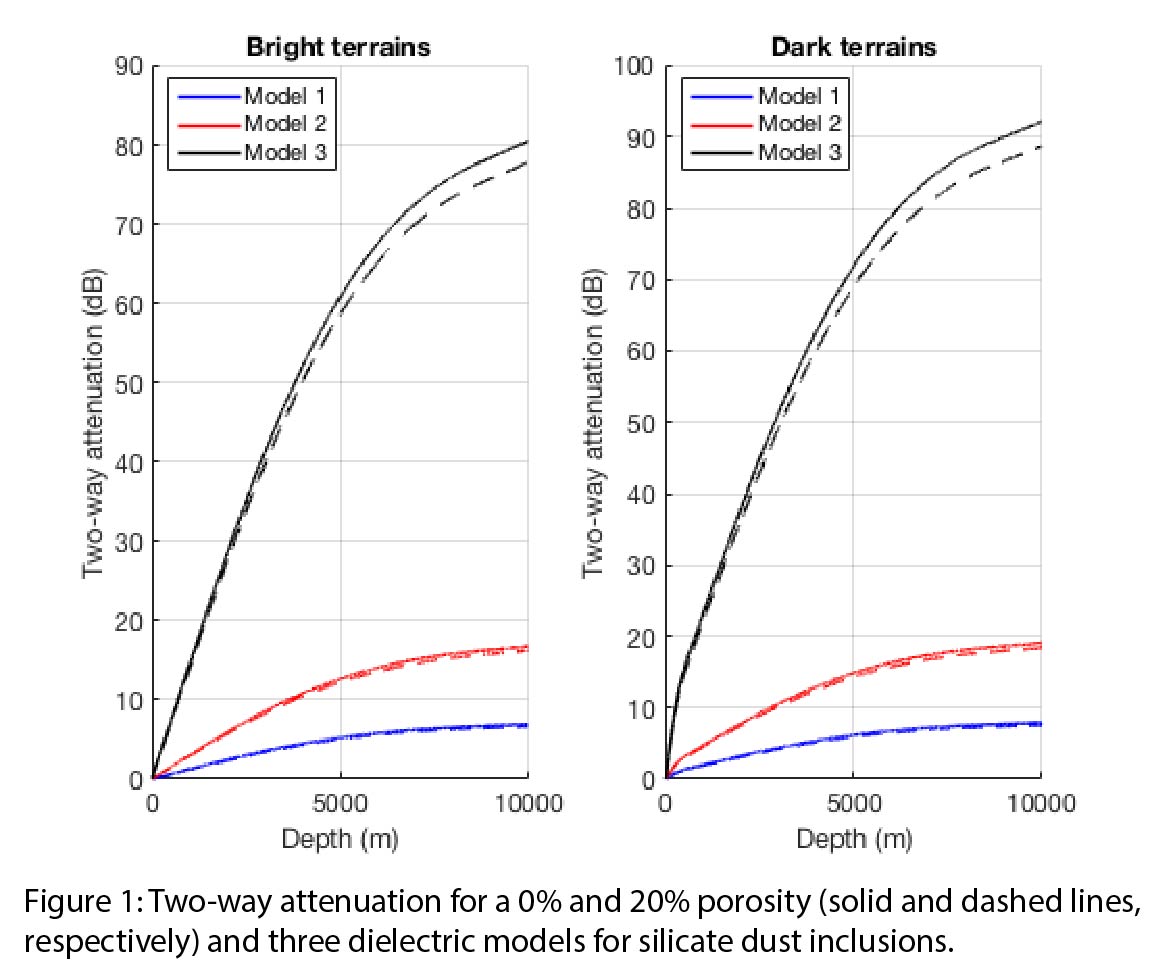
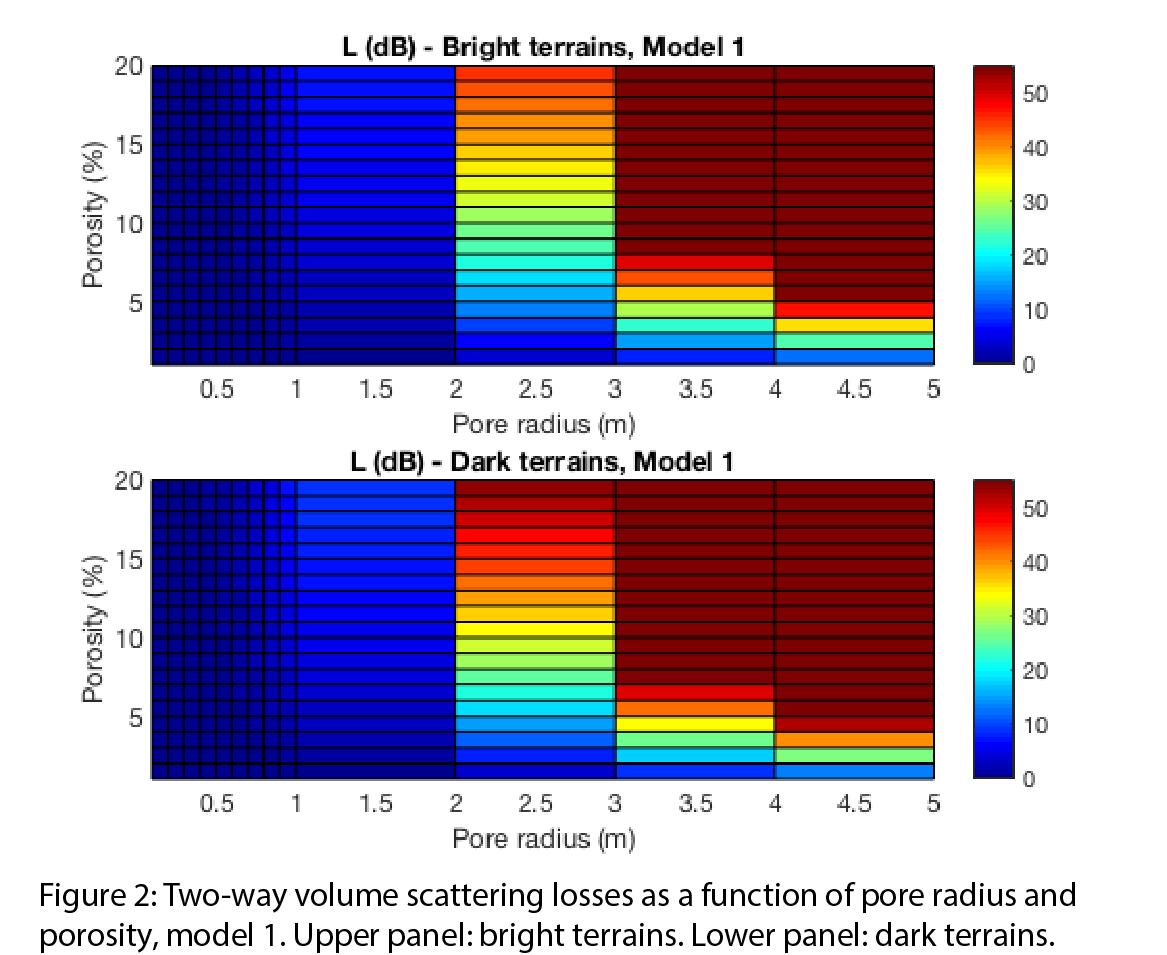
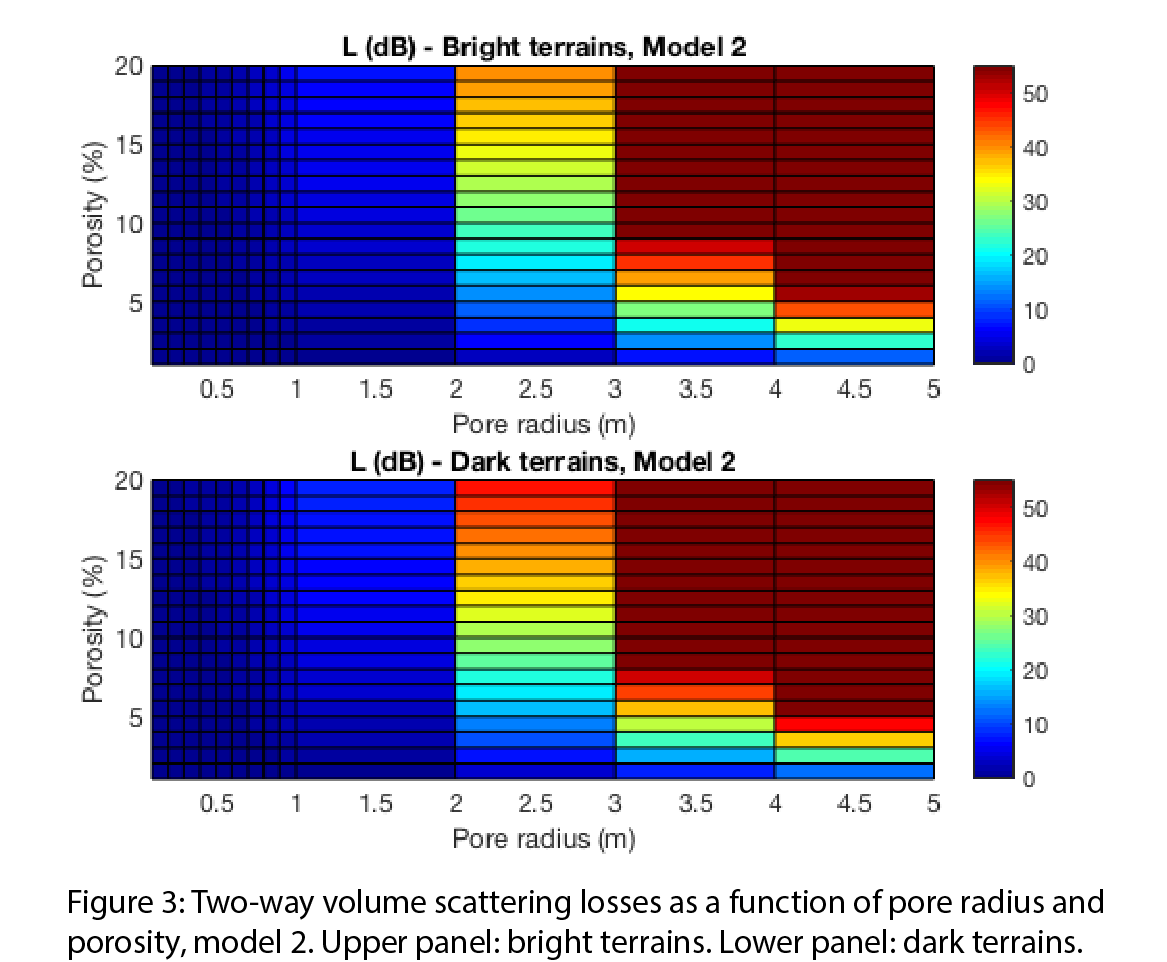
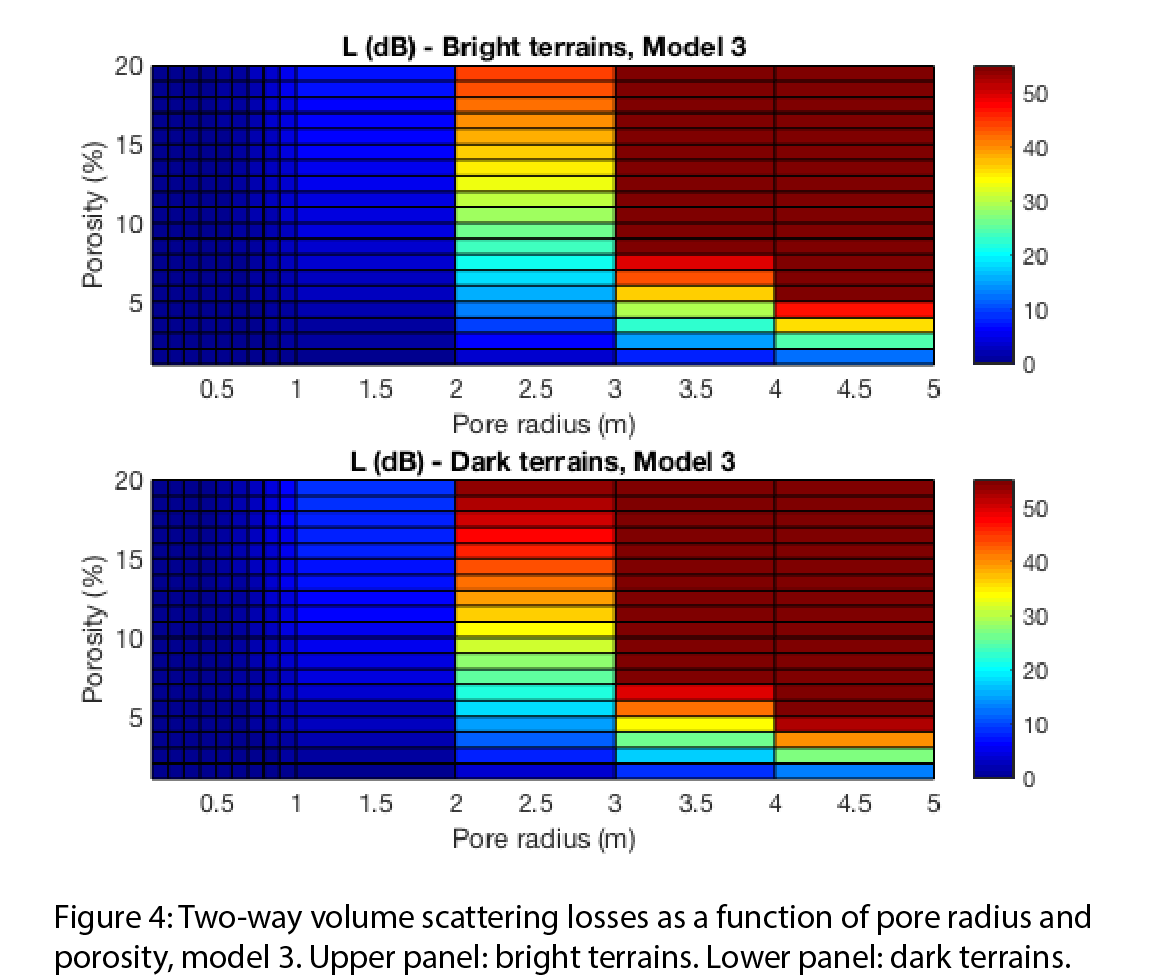
Conclusions
We performed numerical simulations of radar sounding of Ganymede, considering different dielectric models for silicate inclusions in the ice. In the case of a high-attenuation silicate, the attenuation is significantly higher with respect to the other two cases, but the radar sounding of the first kilometers will not be affected. Regarding the volume scattering losses, these will be significative only for pore radius bigger than 2.5 m, and such a value can be reasonably discarded. In such conditions we expect no significant obstacles for the radar sounding of Ganymede.
Acknowledgments
The Authors gratefully acknowledge financial support from the Italian Space Agency through Contract ASI-INAF 2018-25-HH.0.
References
Berquin Y. et al., 2013, Planet. Space Sci., 77, 40-44.
Bruzzone L. et al., 2013, IEEE International Geoscience and Remote Sensing Symposium, 3907-3910.
Di Paolo F. et al., 2014, 15th International Conference on Ground Penetrating Radar, 362- 366.
Di Paolo F. et al., 2016, IEEE J. Sel. Topics Appl. Earth Observ. Remote Sens., 10(1), 118-129.
Di Paolo F. et al., 2018, 5th IEEE International Workshop of Metrology for AeroSpace, 2422-2425.
Heggy E. et al., 2017, Icarus, 285, 237-251.
Ilyushin, Ya.A., 2014, Planet. Space Sci., 92, 121-126.
Kawada, S., 1978, J. Phys. Soc. Jpn., 44(6), 1881-1886.
Sihvola, A. H., 1999, Iet, 47.
Ulaby F. T. et. al., 1986, Addison-Wesle, 436 pp.
How to cite: Di Paolo, F., Lauro, S. E., Cosciotti, B., Mattei, E., and Pettinelli, E.: Radar sounding of Ganymede: Attenuation and volume scattering losses estimation, Europlanet Science Congress 2020, online, 21 September–9 Oct 2020, EPSC2020-291, https://doi.org/10.5194/epsc2020-291, 2020
